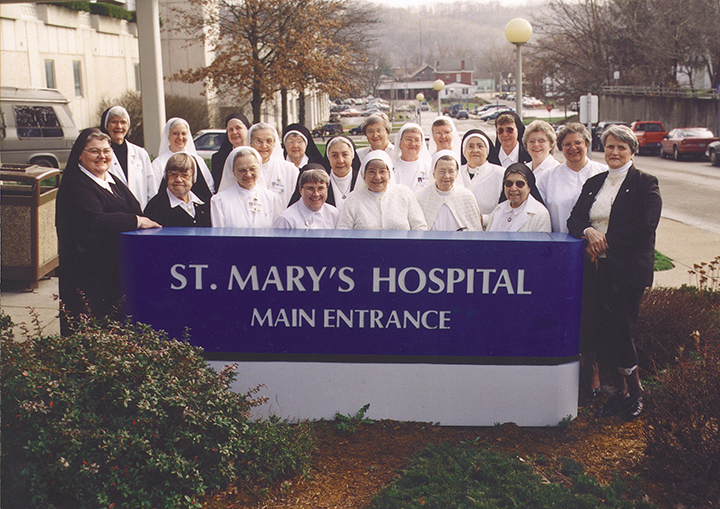By Jack Houvouras
HQ 44 | SPRING 2002
Wanted: Catholic women ages 18 and older; must be willing to leave family and travel great distances; lifelong devotion to God and service to others expected; vows of chastity, poverty and obedience required; must be loving and compassionate toward all those she serves and accepting of setbacks, sufferings and infirmities.
Even in today’s tough economic times this job description would not generate many resumes. But Huntington and the Tri-State region are indeed fortunate the Pallottine Missionary Sisters have answered this call to selfless service and devotion to others.
Originally, it was eight Pallottine Sisters who came to Huntington in 1924 with the purpose of establishing a hospital that would serve the needs of the sick and injured, regardless of their ability to pay. From this humble 35-bed hospital, established on November 6, 1924, St. Mary’s has become the largest tertiary-care hospital in the Tri-State.
The rich history of the Pallottine Missionary Sisters began in early 19th Century Rome. A local priest, Father Vincent Pallotti, trained young Catholic women to serve the needs of the poor during a devastating cholera epidemic. From these first seeds of service grew the Pallottine order, which has spread worldwide over the course of the last 165 years.
While the stories of hardship and sacrifice faced by the early Pallottine Missionary Sisters are numerous, perhaps one of the most compelling involves the Pallottines’ first trip to America. The year was 1912. Four Sisters left their home in Limburg/Lahn, Germany, to begin mission work in the United States.
They had booked passage on a ship leaving from Southampton, England. As they boarded, it was discovered that one of the Sister’s travel documents were not in order. Deciding to remain together they delayed their trip for another three days and set sail on the Bremen. Half way across the Atlantic they passed the wreckage and bodies from the terrible fate of Titanic, the original ship they were to take to New York.
After learning to speak English in Stella Niagara, New York, the Pallottines accepted an invitation to open a hospital in Richwood, West Virginia. From there, eight Sisters were asked to travel to Huntington and transform the abandoned former St. Edwards Preparatory School into a hospital. The rest, you might say, is history.
During its 77 years, St. Mary’s has experienced rapid growth. Today’s Pallottine Sisters are quick to credit the faith, dedication, commitment and hard work of the pioneer Sisters for providing a strong foundation on which later generations have built. No sacrifice was too great for them. They truly saw their work as a vocation, a calling from God, to serve all those who came to them for care.
They also believe God blessed their efforts by sending many loyal physicians, employees and committed citizens of Huntington to help them when they most needed it. The Sisters say that the growth and success of St. Mary’s over the past 77 years is due to the collaboration of the Sisters and the laity living out their mission and values in a faith-based institution.
Another effect of the past 77 years has been the dwindling number of women in the Pallottine order. In the early years at the hospital, at,1east one or more Sisters worked in every department and nursing unit. Currently, there are 11 Pallottine Sisters working in some capacity at St. Mary’s.
The Pallottine Sisters are still committed that St. Mary’s will stay true to its Catholic identity even in the face of the possibility that no Sisters will be present at the facility one day.
The Sisters hope that the board, administration, management, physicians and employees will be so imbued with their mission and values that they will see themselves as owners and stewards of the hospital and will continue to live the Catholic ministry.
As is typical for the Pallottine Sisters, this commitment to instilling the “people” of St. Mary’s with a sense of their responsibility to those they serve is more than rhetoric. The hospital has recently entered into an extensive phase of customer and employee satisfaction training.
Sister Diane Bushee, S.A.C., St. Mary’s vice president of Mission Integration, explains, “Currently we are in the process of implementing a Service Excellence Initiative through which we hope to ‘hardwire’ standards of behavior, and all those who participate in our ministry will be expected to follow them.
“Hopefully, this will allow those we serve, patients and their families, physicians and employees, to know what they can expect from us. We also provide opportunities for our board and management staff to gain a better understanding and appreciation of what we mean when we say health care is a ministry to God’s people rather than simply another business.”
Sister Celeste Lynch, S.A.C., president of Pallottine Health Services, Inc. (PHS), the corporation which sponsors and provides guidance to both St. Mary’s and St. Joseph’s Hospital in Buckhannon, WV, agrees.
“If we lose our Catholic identity, we lose our reason for existing. Catholic health care ministry should not be evaluated in terms of its profits, power or numbers, but rather in terms of its fidelity to the healing ministry of Christ.”
“The vision of justice and peace is at the core of our Catholic identity,” she continues. “Christ came to ‘bring good news to the poor, liberty to the captives, sight to the blind, and freedom to the downtrodden.’ Today the poor are those without adequate health care, the captives are those affected by discrimination, poverty, disease or poor health. The blind are those blinded by prejudice or indifference, and the downtrodden are those whose lives and dignity are at risk because they lack access to health care.
“We advocate for those who have no voice: the unborn and the uninsured/underinsured and for a national policy which protects life and dignity at all stages of life. We seek to comfort those who are ill, whether they can be cured or not, so that they find strength and comfort in knowing God’s abiding love for them.”
And what are the Sisters’ future hopes for St. Mary’s Hospital? Sr. Diane replies, “We hope that St. Mary’s will continue to collaborate with other healthcare facilities, churches, charitable agencies, educational institutions and ecumenical and inter-faith initiatives.
“We hope to be able to identify and meet currently unmet health needs of the community within the scope of our resources. We truly hope that St. Mary’s will be a place where employees want to work, patients want to come for their care, and physicians want to practice.





